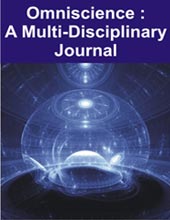[{“box”:0,”content”:”[if 992 equals=”Open Access”]n
n
Open Access
nn
n
n[/if 992]n
n
n
n
n

n
Seema Arora
n
- n t
n
n
n[/foreach]
n
n[if 2099 not_equal=”Yes”]n
- [foreach 286] [if 1175 not_equal=””]n t
- Principal Department of Architecture, C T Institute of Higher Studies, Shahpur, Jalandhar Punjab India
n[/if 1175][/foreach]
n[/if 2099][if 2099 equals=”Yes”][/if 2099]n
Abstract
nMan consists of two factors, the mind and the body. Mind with its perception is said to be directly opposed to, though somehow or other familiarly connected with, the body with its extension; for, the mind has no expansion; and the body, consciousness. Now, the consciousness of mind assumes the form of reason in man, while consciousness is the common property of all living beings. Hence is the eminent, yet much damned, definition of man, man is a rational animal. In this way, man has two sides – a higher coherent side; a lesser animal one. A perfect man is he who can work out a perfect synthesis between these two sides of his nature with, of course, the higher controlling the lower, as natural and beneficial. A perfect society also, therefore, is one in which there is such a perfect synthesis between spiritualism and materialism, with, of course, the earlier scheming the latter, as predictable and essential. Society is, of course, a celestial institution. Still, from the practical point of view, its internal divinity, real nature, has to be manifested. And, then this great fact has to be kept in mind, viz. that it has to manifest, and not constructer Truth. As a matter of fact, Truth, real Truth cannot be contrived at all at will; it can be only manifested through wisdom and good sense. Vivekananda’s concept of society, though derived from Vedantik philosophy, seeks to integrate both the spiritualistic and worldly interpretations of both man and society; it is both individualistic and socialistic. Believing in the divine nature of man, Vivekananda seeks to establish a continuum between society, culture and civilization, like the wick, oil and the flame. This approximates the essential view of both man and society.
n
Keywords: Divine, manifest, consciousness, spiritualism & materialism.
n[if 424 equals=”Regular Issue”][This article belongs to Omni Science: A Multi-disciplinary Journal(osmj)]
n
n
n
n
n
nn[if 992 equals=”Open Access”] Full Text PDF Download[/if 992] n[if 992 not_equal=”Open Access”]
[/if 992]n[if 992 not_equal=”Open Access”] nnn[/if 992]nn[if 379 not_equal=””]n
Browse Figures
n
n
n[/if 379]n
References
n[if 1104 equals=””]n
- (1989). The Complete Works of Swami Vivekananda. Calcutta : Advaita Ashrama, , vol. III, p. 156.
- Majumder, Remesh Chandra.(1963). Centenary Memorial. Calcutta: Advaita Ashrama, vol. I, p. 353.
- (1970). Caste, Culture and Socialism. Calcutta: Advaita Ashrama,. p.4.
- Ganbhirananda, Swami.(1960). The Life of Swami Vivekananda. Calcutta: Advaita Ashram.Vol. II, p. 685.
- Ganbhirananda, Swami.(1960). The Life of Swami Vivekananda. Calcutta: Advaita Ashram, Vol. II, p. 790.
- Shankar, Tarini.(1963). Patriot-Saint Vivekananda. Allahabad: R.K. Mission.
- Veyas, Ved. Ed. Kisari Mohan Ganguali. (1883).Mahabharata. Calcutta: XVIII 5.62.
- Dutta, (1954).B.N. Vivekananda : Patriot-Prophet. Calcutta: Nababharat Publishers. p. 335.
- Nirvedananda, (1987).Swami. Vivekananda, India and Her Problems. Calcutta: Advaita Asharama, p. 39.
- Vivekananda (1970).Caste, Culture and Socialism. Calcutta: Advaita Ashrama. p. 3.
- Vivekananda(1970).Caste, Culture and Socialism.Calcutta: Advaita Ashrama. p. 5.
- Ganguly, Manmohan. (1907). Swami Vivekananda: A Study. Calcutta: Contemporary Publishers. p.27
nn[/if 1104][if 1104 not_equal=””]n
- [foreach 1102]n t
- [if 1106 equals=””], [/if 1106][if 1106 not_equal=””],[/if 1106]
n[/foreach]
n[/if 1104]
nn
nn[if 1114 equals=”Yes”]n
n[/if 1114]
n
n

n
n
n
n
n
| Volume | 14 | |
| [if 424 equals=”Regular Issue”]Issue[/if 424][if 424 equals=”Special Issue”]Special Issue[/if 424] [if 424 equals=”Conference”][/if 424] | 02 | |
| Received | January 15, 2024 | |
| Accepted | February 1, 2024 | |
| Published | May 27, 2024 |
n
n
n
n
n
n function myFunction2() {n var x = document.getElementById(“browsefigure”);n if (x.style.display === “block”) {n x.style.display = “none”;n }n else { x.style.display = “Block”; }n }n document.querySelector(“.prevBtn”).addEventListener(“click”, () => {n changeSlides(-1);n });n document.querySelector(“.nextBtn”).addEventListener(“click”, () => {n changeSlides(1);n });n var slideIndex = 1;n showSlides(slideIndex);n function changeSlides(n) {n showSlides((slideIndex += n));n }n function currentSlide(n) {n showSlides((slideIndex = n));n }n function showSlides(n) {n var i;n var slides = document.getElementsByClassName(“Slide”);n var dots = document.getElementsByClassName(“Navdot”);n if (n > slides.length) { slideIndex = 1; }n if (n (item.style.display = “none”));n Array.from(dots).forEach(n item => (item.className = item.className.replace(” selected”, “”))n );n slides[slideIndex – 1].style.display = “block”;n dots[slideIndex – 1].className += ” selected”;n }n”}]

